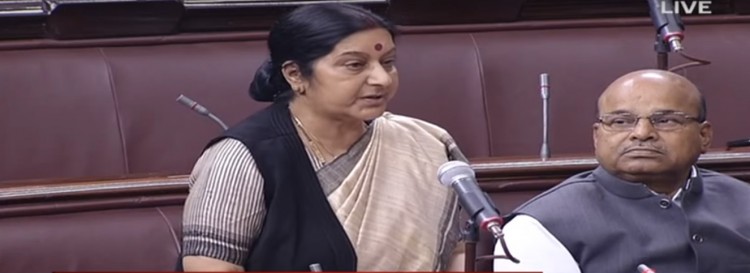Three factual mistakes in Indian foreign minister’s statement on Nepal
Sujit Mainali / December 8, 2015
During the winter session of India’s Rajya Sabha (Upper House) on December 7, 2015, Indian foreign minister Sushma Swaraj spoke about Nepal’s new constitution and Nepali politicians.
South Asia Check has examined to see whether her statements are fact-based:
First statement: When Indian girls would be married off to Nepal, they as daughters-in law would be granted naturalized citizenship through matrimony. But the new constitution has erased the provision of naturalized citizenship through matrimony.
Fact: Clause 6 of Article 11 of the new constitution has clearly mentioned that “a foreigner woman married to a Nepali man can acquire naturalized citizenship in accordance with the federal law, if she so desires.”
Thus, this statement of Indian foreign minister is wrong.
Second Statement: When constitution was being drafted (in Nepal), Bidya Bhandari came here (New Delhi) in January 2015. Baburam Bhattarai came in March 2015. Prachanda came in July 2015. Sher Bahadur Deuba came in August…leaders of all big parties came here. Sher Bahadur Deuba is from Nepali Congress, Bidya Bhandari is from the Marxist-Leninist [party]. Both parties were in government…Marxist-Leninist [party] was a coalition partner in the Nepali Congress-led government.
Fact: India’s foreign minister said Bidya Bhandari (who is now the President of Nepal) was the leader of Marxist-Leninist party [CPN-ML] and further said Marxist-Leninist party was a coalition partner of the Nepali Congress-led former government of Nepal.
Swaraj is right in saying that the CPN-ML was a coalition partner in the NC-led government. But Bidya Bhandari who visited New Delhi was not the leader from CPN-ML, but from CPN-UML, the second largest party of Nepal.
After being elected as the president of Nepal, Bhandari resigned from the CPN-UML. Before resigning, she was the vice chairperson of the CPN-UML.
So, this statement of Indian foreign minister is also wrong.
Third Statement: The constitution of Nepal which was endorsed without holding any discussions not only failed to address the new demands [of the agitating Madhes-based parties], but also reversed the (provisions) of the (Interim) Constitution 2007.
Fact: The Constituent Assembly (CA) prepared a preliminary draft of the constitution and held discussions on its provisions, both inside and outside the CA. Public feedback on the draft constitution was also collected.
When the preliminary draft was being discussed, agitating Madhes-based parties also commented about the provisions of the draft constitution from outside the CA.
Click here to read a statement made by agitating Unified Democratic Madhesi Front (UDMF) leader Mahantha Thakur about the provisions of the draft constitution.
After holding discussions on the preliminary draft, the CA prepared a revised bill of the constitution.
Amendment proposals on the revised bill of the constitution were collected from CA members and the articles of the constitution were passed one by one in accordance with the process envisioned by the Interim Constitution-2007.
Click here to see the amendment proposals on the revised bill of the constitution.
The constitution was endorsed by the CA on September 17 and was promulgated on September 20.
Therefore, the Indian foreign minister is wrong in saying that the new constitution was promulgated without holding discussions on its provisions.
This material is copyrighted but may be used for any purpose by giving due credit to southasiacheck.org.
Comments
Latest Stories
- In Public Interest Covid-19 cases are low, but that’s not an excuse to avoid vaccination
- In Public Interest What is BF.7, the sub-variant that has the world by its grip?
- In Public Interest Threat of a new Covid-19 wave looms large amid vaccine shortage in Nepal
- In Public Interest As cases decline, Covid-19 test centres in Kathmandu are desolate lot
- In Public Interest Dengue test fee disparity has patients wondering if they’re being cheated
- In Public Interest As dengue rages on, confusion galore about what it is and what its symptoms are. Here’s what you need to know
In Public Interest
 Covid-19 cases are low, but that’s not an excuse to avoid vaccination
The Pfizer-BioNTech bivalent vaccines authorised by the Nepal Government provide better protection a...
Read More
Covid-19 cases are low, but that’s not an excuse to avoid vaccination
The Pfizer-BioNTech bivalent vaccines authorised by the Nepal Government provide better protection a...
Read More
- What is BF.7, the sub-variant that has the world by its grip?
- Threat of a new Covid-19 wave looms large amid vaccine shortage in Nepal
- As cases decline, Covid-19 test centres in Kathmandu are desolate lot
- Dengue test fee disparity has patients wondering if they’re being cheated
- As dengue rages on, confusion galore about what it is and what its symptoms are. Here’s what you need to know
